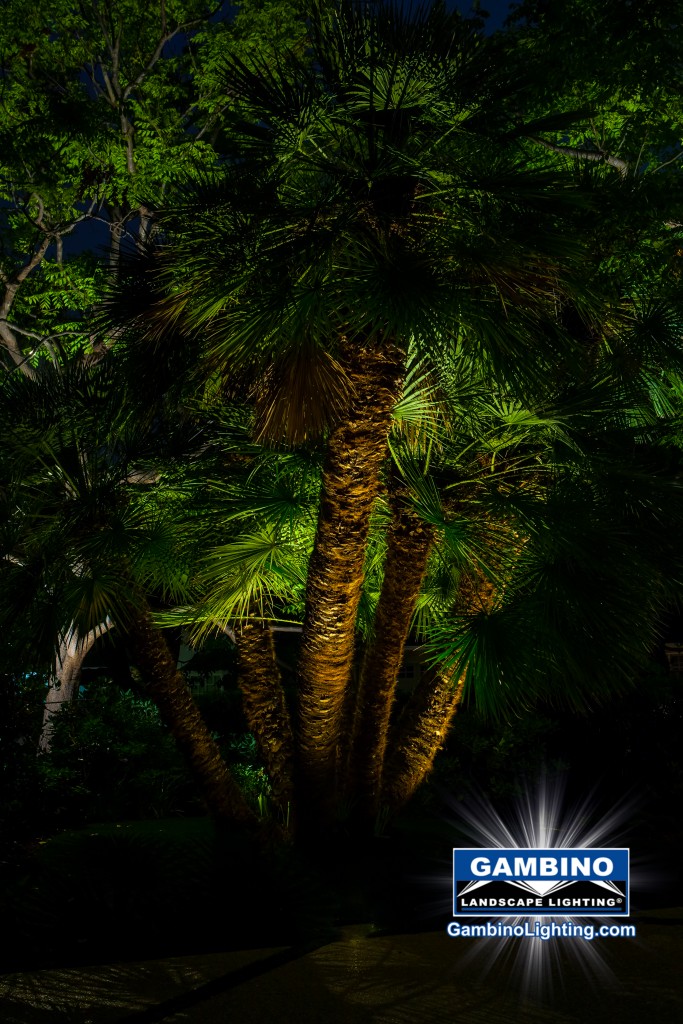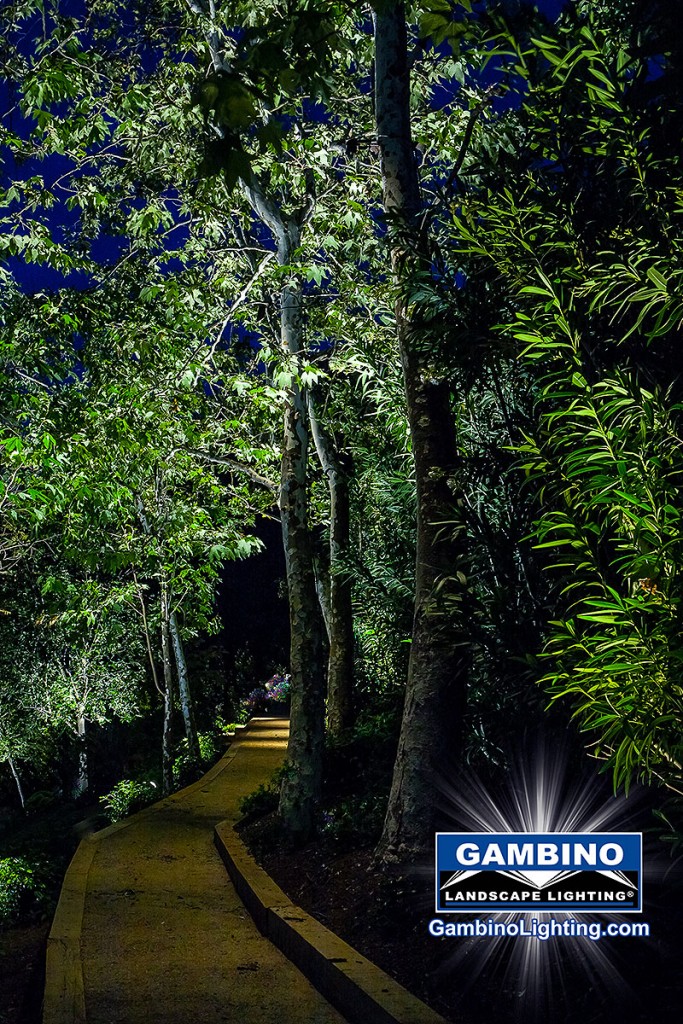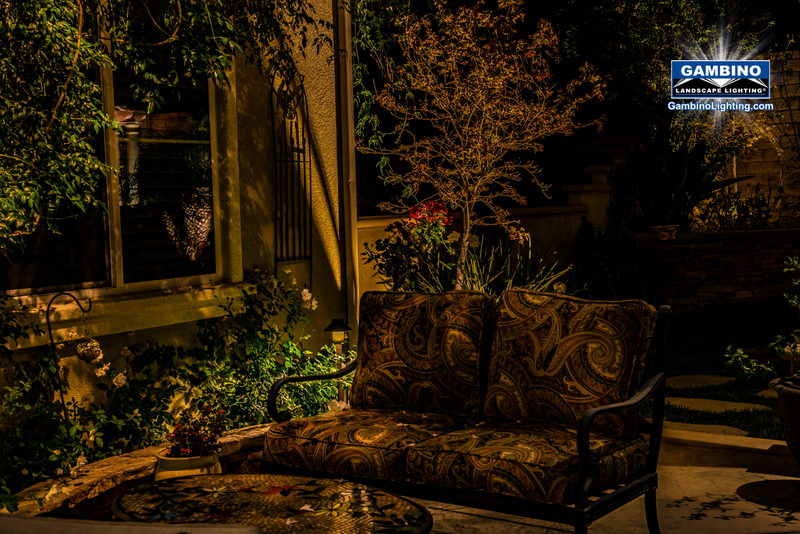05 Feb How to Select Trees and Shrubs in your garden to Illuminate at Night
By Mike Gambino
If you are fortunate your property already has many thriving, established, healthy and vibrant trees, shrubs and plants that are prime candidates for accent lighting at night.
A healthy young plant with a strong form is more likely to show well in your yard during the day and illuminate nicely at night. Here’s what to look for when selecting plants to illuminate on your property.
Let’s start with a glossary to help you understand different plant types found in southern California and the terminology you will encounter in the garden. This is by no means a comprehensive list.
 Tree and Shrub Types
Tree and Shrub Types
- Conifers are plants with needles that produce cones such as, pines, Cypress, Spruce and cedars. Some are open formed which lends themselves to up and down accent lighting from within the drip line of the tree and others are dense canopied which lend themselves to positioning fixtures outside of the drip line either in front or from behind primary site lines of the plants to produce different effects.
- Broad-leaved plants have leaves year around and typically produce flowers and fruit. Examples such as Strawberry tree, Guava, Bottle tree, Ficus, Sumac, Citrus, Giant bird of paradise. generally lend themselves to dramatic uplighting or backlighting to create silhouettes.
- Deciduous plants lose their leaves or needles in winter. For example Japanese pears, Japanese maple, Liquidambar, Sycamores, Most are large trees that are suitable for both up lighting and downlighting out of as they will support the attachment of lighting equipment to them.
- Evergreen plants have leaves or needles year-round; some examples are Southern magnolia, Juniper, Some species of Oak, Olive. Density and form will vary among types and species and will dictate which lighting effect can be used to make them look their best.
- Palms are evergreen large and spiky leaved plants. These plants can be effectively uplighted to be made focal points in the night garden. Their uneven trunks can also be highlighted to show texture and create interest.
- Ferns are evergreen plants with soft green leaves some finely cut and delicate. Leaves are usually translucent which allows light to pass through and create interesting shadows on floors or walls good for either up lighting or down lighting.
- Ornamental grasses are either evergreen or die back in the winter and this should be noted before deciding if or how these are to be illuminated. (Source: https://www.thetreecenter.com/flowering-trees/crape-myrtle-trees/)
- Ornamental Flowers and Ground covers are either evergreen year around or seasonal Color displays. Like ornamental grasses the habits of each type should be considered before downlighting them to draw attention.
 What to Look for in a Tree
What to Look for in a Tree
Choose your favorite trees on your property and study their form and growth. Use this checklist to determine if the plant is a good one to illuminate or mount fixtures to.
Strong form: Also called structure or growth habit, the form of a plant should be strong and full. This means there should be no uneven gaps in the canopy or asymmetrical habit. Trees that are single-stem should have one main trunk, or leader. Multi stemmed shrubs and trees should be full, with no crossing dead or broken branches or leaves. Proper horticultural Pruning can most times correct deficiencies so plants look their best at all times.
- Healthy vegetation:The leaves should be free of major damage from insects and wind, and they should have a uniform color and shape that’s consistent with the species’.
- No bad insects or fungus present:Harmful insect infestations, mildew, fungus or discoloration should be treated immediately, as it could be detrimental to the health and appearance of the plant.
- Look for uniformity.Uniform lighting is very important with multiple plants of the same species that are grouped together. When planting a grouping of trees, for example, the design’s success hinges on the trees’ uniform growth and planting, the lighting must be reflect this and be consistent so all appear as same. The same is true when lighting several shrubs of the same species for a hedge or privacy screen. You will want to light the overall structure to create a uniform appearance at night.
Look for special forms. Specimen trees and plants with a sculptural form, like a twisted Japanese maple or a palm tree with a curving trunk can be lit as a focal point in the landscape.
 Factors That Influence Cost
Factors That Influence Cost
Viewing angles, Size, density and plant structure will all dictate how many and what type of lighting equipment will be needed to effectively illuminate that tree or plant.
Ultimately, choosing plants that look good during the day to illuminate at night is a safe choice. However skilled landscape lighting designers can make those not so great looking plants during the day really shine at night.
 This landscape lighting blog is published by Mike Gambino of Gambino landscape lighting inc. all rights reserved. Mike is a professional landscape lighting system designer/ builder and has been designing, installing and maintaining landscape lighting systems for more than 20 years. Mike resides in the Los Angeles area with his wife and 2 sons. To visit his website go to www.Gambinolighting.com . To inquire about hiring Mike please click here .
This landscape lighting blog is published by Mike Gambino of Gambino landscape lighting inc. all rights reserved. Mike is a professional landscape lighting system designer/ builder and has been designing, installing and maintaining landscape lighting systems for more than 20 years. Mike resides in the Los Angeles area with his wife and 2 sons. To visit his website go to www.Gambinolighting.com . To inquire about hiring Mike please click here .
Blog articles may be published with permission on other websites without editing or removing links.



No Comments